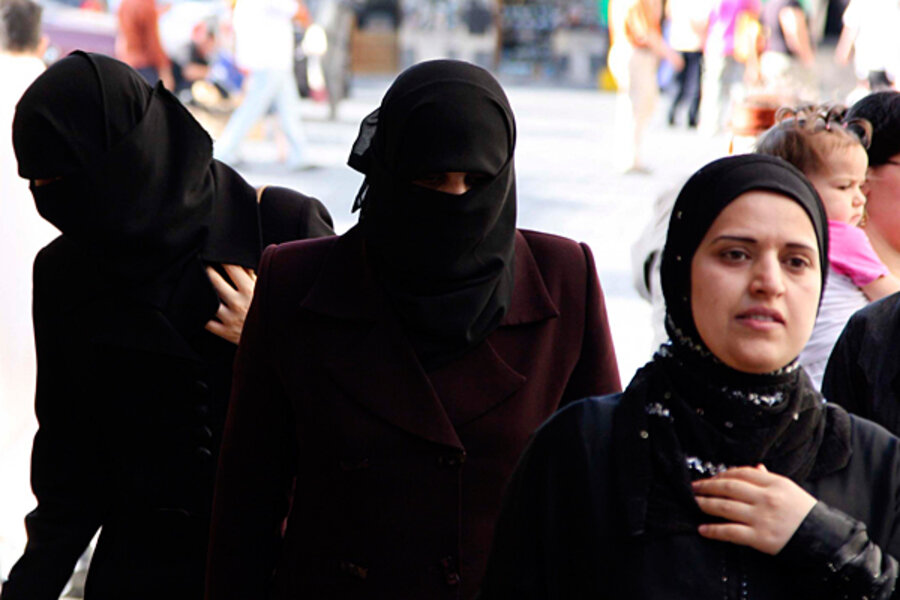Veil ban: Why Syria joins Europe in barring the niqab
Loading...
| Cairo
Syria has banned students and teachers at universities from wearing the niqab, the full-face veil that has grown in popularity there in recent years.
The decree, which came Sunday on the heels of a move toward similar bans across Europe, is an attempt to preserve Syria's traditional role as the Middle East's bastion of secularism.
“Syria is adamant about its secularism,” says Joshua Landis, director of the Center for Middle East Studies at the University of Oklahoma. “If the next generation is going to be raised to embrace the strict Islamic values for which the niqab is the expression, it will undermine the project Syria is trying to build, of secularism and coexistence of religions. “
Syria’s Ministry of Higher Education issued the decree on Sunday, banning the facial veil from both public and private universities. A government official told Al Arabiya television that the niqab, which blocks all but the eyes from view, was “against academic principles.” Last month, the Education Ministry removed hundreds of primary and secondary teachers who wore the niqab from their teaching positions.
Secularism is particularly important to Damascus because the president comes from the minority Alawite Muslim sect. Though many sects of Islam and Christianity coexist in Syria, it is majority Sunni. And the regime is particularly sensitive to Islamism: Nearly three decades ago, President Bashar al-Assad’s father brutally put down an Islamist uprising, killing thousands of civilians by leveling the town of Hama, where the rebellion was centered.
By banning the niqab, Syria is now heading into waters that have proved difficult for Egypt in recent years, where courts have struck down bans on the niqab.
Gulf influence
The niqab has become increasingly visible in many societies across the Middle East, particularly in secular nations where miniskirts were once appropriate street attire for women. Some say it marks a wave of conservatism picked up by workers who move to Saudi Arabia and other Gulf nations and then bring those countries' conservative brand of Islam home with them.
The Gulf influence is often cited in Egypt, where the number of women wearing the niqab has increased exponentially over the last decade.
Egypt is less secular than Syria, but the regime suppresses Islamist movements, including the most powerful opposition movement, the Muslim Brotherhood.
Several attempts to ban the niqab have been struck down by Egyptian courts in the past five years, including one by the American University in Cairo and attempts by the government to ban the veil in public university dormitories and during exams.
Hossam Baghat, director of the Egyptian Initiative for Personal Rights, says the government needs to focus on ways to promote a tolerant version of Islam rather than banning people’s personal and religious expression.
“Of course we don't agree with what the niqab represents, but we believe strongly that taking punitive measures against women who wear the niqab is not an effective way to promote tolerance and a moderate interpretation of Islam,” he says.
Why Syria's ban unlikely to face court challenge
But in Syria, where courts do not enjoy the moderate level of independence of the Egyptian judicial system, the government’s ban will not likely face a challenge. That’s all right with Bassam al-Kadi, director of the Syrian Women Observatory, a women’s rights group in Damascus. He considers the niqab an extremist message that reduces women to sexual objects that must be covered.
Mr. Kadi says the rise of the niqab in Syria has been partly fueled, as it was in Egypt, by ideas imported from the Gulf. But it also has to do with the political isolation of Syria in the last five years, he says, during which Syria strengthened its ties with its more conservative neighbor Iran and continued its support for Hezbollah and Hamas.
“Extremists have more and more power in the last five years, and they are changing Syrian society, “ says Kadi.
Niqab favored by burgeoning women's religious intellectual movement
But Landis says that in Syria, at least, the issue is a complex phenomenon that cannot simply be attributed to a wave of extremism. It actually marks a growing religious intellectual movement among middle-class women in Syria, he says. Religious groups led by women and encouraging study and intellectual thought are developing a growing following, particularly in schools, where women have carved out a space in the male-dominated workforce.
Many women donning the niqab are doing so of their own conviction, and are “independent and headstrong,” says Landis, who travels regularly to Damascus.
“It’s a way to assert themselves, to assert their individuality,” he says. “They’re going against prevailing social norms. Most of the women who do this, their families don’t like it.”
The movement includes elements of feminism, he says, which might be unfamiliar to Western women, to whom feminism conveys the idea of less clothing, not more.
In Egypt, a lower-class phenomenon
In Egypt, those who wear the niqab are more likely to come from low-income families. But even here, the reaction to the facial veil cannot be molded into a divide between the upper and lower classes. Amal, an Egyptian who works as a maid and earns a low monthly income, says she disagrees with the niqab.
“I wish they would ban the niqab here, too,” she says. “It brings a lot of problems. Sometimes men wear them and do bad things.”
Amal, who asked that her last name not be used, says she believes Muslim women should wear the hijab, the scarf that covers the hair, and dress modestly, but that the Koran does not tell women to cover their faces.
“Frankly, when someone walks behind me wearing the niqab, I'm afraid. I don't know if it's a man or a woman, or if they will do something bad.”
Related:





